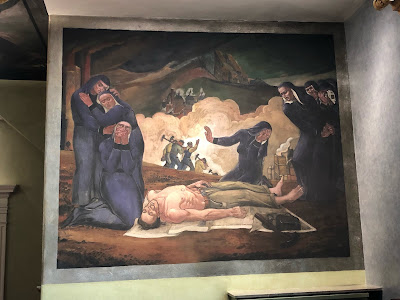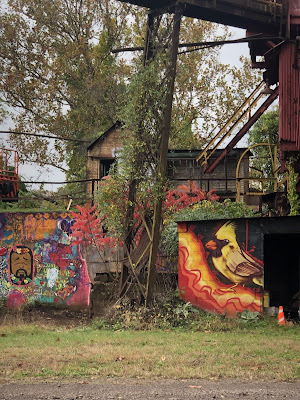This past Wednesday, I flew to Jeff’s hometown as part of a museum tour group. I came to this place with mixed emotions. There is so much beautiful art and architecture to admire in Pittsburgh, and I did. On the other hand, I am the granddaughter of a coalminer in western Pennsylvania who died of black-lung and left behind my nine-year-old father and his siblings, ranging in age from 14 to 2 years. My widowed grandmother and her children were immediately evicted from the house she lived in, because there was no longer a miner living there. My anger about the resultant pain and deprivation that plagued my father’s young life cast a pall over my enjoyment of the trip. I saw many manifestations of the wealth that people like my grandfather died producing. As with many other places, many of Pittsburgh's historic glories were made on the backs of poor immigrant labor.
That said, I found Pittsburgh to be an interesting place with many wonderful things to see and experience. Here is a photo record of them.
I loved the bridges:
Rivers of Steel, the Carrie Blast Furnace Site:
This was my absolute favorite of the places we visited—fascinating, marvelous to photograph, and replete with history of the the otherwise forgotten workers who made America possible. That’s it behind me in the selfie photo at the top of this post. At the beginning of the 20th century this installation fed a river of molten iron to the steel mills across the river. Today is it a place where people learn about its history, artists decorate it and also cast their sculptures in iron and aluminum.




































Great pix, Annamaria. And as another miner's granddaughter (Nottinghamshire) I share your fascination with the subject. Great pictures. I particularly like the one of the sunbathing bunny. Or is it a hare?
ReplyDeleteThank you Zoe, I still have that picture you and I took with Val McDermid in Reykjavík, three crime writers with all with coal miner grandfathers! Sorry to say, I am not sure I know the difference between a rabbit and a hare, so I’m not sure which that lovely statue is. To me, he physically resembled Bugs Bunny. When I walked up to it, I said “What’s up Doc?” It didn’t answer.
DeleteI'm pleased you're back safely!
ReplyDeleteThank you, Stan. I enjoyed getting to know Pittsburgh better. I had visited there only once before, and this time I was very happy to see sites that may not even have been in existence a couple of decades ago. Especially the church and the blast furnace
DeleteLOL. It looks to me as if your tour guide was a Cleveland Browns fan. :) Yep, Pittsburgh is my home turf and I'm proud of it. I grew up when those steel mills were actually functioning, in neighborhoods filled with men (some relatives) who worked in those mills, and at 17 I served as a health inspector charged with inspecting the lack of sewage disposal facilities in a "coal company town" within county limits. I have no illusions about the history of industrial Pittsburgh. The Fricks, the Carnegies, the Mellons...and others...were robber barons in Pittsburgh but glorified in places like New York City for the libraries and museums they created there. Today, Pittsburgh is a world renown medical, educational, cultural, and technology center, serving as a magnet for young, bright, creative minds from around the globe, and continually ranks among America's top most livable cities. In closing, GO STEELERS.
ReplyDeleteHiya Bro, I have no knowledge whatsoever of the Cleveland Browns. Do they play football or hockey? It’s probably football, a sport which I hate so much I don’t even want to walk past the television screen with football players on it, as I am sometimes forced to do.
DeleteAnd I promise I won’t say anything about their having put you in charge of sewage.
I loved what I saw in Pittsburgh. It is exactly as you described it. Our tour guide was a young woman, working class like me, who had a great deal of sensitivity to the past. Not everyone else on the tour reacted as I did. Some of the people seemed shocked by our compassion for those who suffered and died to grow the fortunes of the robber barons. A response to all that misery that I know you and I share. .
Commentary that gives me a lot to think about. I know Pittsburgh well. When I was around 7 or 8, my dad, a truck driver, made deliveries to U.S. Steel. We arrived in the middle of the night and the place was a flaming cauldron. While my dad made deliveries, I had to wait with the security guards, who gave me US Steel pencils, still the best I've ever owned. In college, I was an intern at KDKA-TV/radio and so learned so much about the city. It's a very, very complicated city, as you suggest. I remember seeing the movie of "Gypsy" at the Stanley Warner Theater. About the third time Roz Russell said, "I had a dream," the woman behind me said, "Her and her goddam dreams." I will leave it at that.....
ReplyDeleteThank you so much for your comments. It makes me very happy to know that someone who really knows the town sees it in such a similar way. The anecdote you wrote about the woman in the movie theater is moving and revealing. What a response to someone on the silver screen bragging about her dreams from a person who probably, in those days in Pittsburgh, couldn’t find much to be hopeful about. Makes a person weep.
DeleteWhat a fantastic description of Pittsburg, geat photos, and, of course, I sympathize with the lot of the miners and their families.
ReplyDeleteMy father was an organizer for a miners' union, and we lived in Chicago for several years in the 1950s. When we drove east, we always saw the smoke coming out of the Pittsburgh steel factories. Those workers also have my symmpathy, especially when steel factories shut down.
The working-class history of this country is one vast part that should be taught.
Oh Kathy, the steel companies had a list of what they would pay out for injuries. If a worker lost a little toe, he got nothing because such an injury did not deprive him in any way. At least that’s what they thought. The largest payments and the best medical care were given to people with injuries, which when cured would allow the worker to return to the job. They counted the investment in his treatment worth making, since they would then get back a trained worker. The whole thing was completely heartless. Return on investment was the only measure.
DeleteAnd, I ask, with tongue in cheek, have times changes so much?
ReplyDeleteGetting sick pay out of big corporations during Covid last year was impossible. Workers were told to go to work sick in many places, especially meatpacking and poultry factories.
It's still Dickensian in many ways.